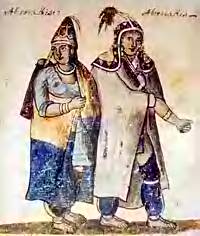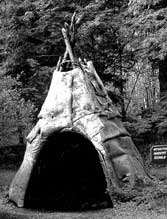Abenaki
 Flag of Western Abenaki | |
| Regions with significant populations | |
|---|---|
| United States (Maine, New Hampshire, Vermont) Canada (Quebec) | |
| Languages | |
| English, Abenaki | |
| Related ethnic groups | |
| Algonquian peoples |
The Abenaki (also Wabanaki) are a tribe of Native Americans/First Nations belonging to the Algonquian peoples of northeastern North America. The two major tribes within the Abenaki people are Western Abenaki and Eastern Abenaki.
The term Wabanaki means "Dawn Land" in the Abenaki language, from waban ("dawn" or "east") and ki ("land")—the aboriginal name of the area broadly corresponding to New England. It is, therefore, sometimes used to refer to all the Algonquian language speaking peoples of the area — Western Abenaki, Eastern Abenaki, Maliseet-Passamaquoddy, and Micmac — as a single group.
History

The Abenakis were traditionally allied with the French; one of them, Assacumbuit, was declared a noble under the reign of Louis XIV.
Facing annihilation from English attacks and epidemics, they started to emigrate to Quebec around 1669, where two municipalities were given to them. The first was on the Saint Francis River and is nowadays known as the Odanak Indian Reservation; the second was founded near Bécancour and is called the Wolinak Indian Reservation.
When their principal town, Norridgewock, was taken, and their missionary, Father Sebastian Rasle, killed in 1724, many more emigrated to the settlement on the St. Francis River where other refugees from the New England tribes had come to earlier. As of the early 1900s, they were represented by the Amalectites on the St. John River, New Brunswick, and Quebec (820); the Passamaquoddies, on the bay of that name, in Maine (300); the Penobscots, at Old Town, Maine (400), and the Abnakis at St. Francis and Bécancour, Quebec (430).[citation needed]
After the unsuccessful attempt of de la Saussaye, in 1613, to plant a colony at Mount Desert — where the Jesuit Fathers Biard, Masse, and Quentin proposed to evangelize the Indians — the Capuchins and the Augustinian Recollects, aided by secular priests from the seminary of Quebec, undertook the work but met with indifferent success. The Jesuit Druillettes was sent to them in 1646, but remained only a short time. Subsequently, other missionaries like Bigot, Thury, and de la Chasse laboured among them, but three years after the murder of Father Rasle, that is to say in 1727, when Fathers Syvesme and Lauverjat withdrew, there was no resident pastor in Maine although the Indians were visited by priests from time to time. In the early 1900s, there were Indian missions for the remnants of the tribe at Calais, Eastport, and Old Town.[citation needed]
Abenakis are not a federally recognized tribe in the United States, unlike almost all of the other eastern tribes. This may change: Vermont officially recognized the Abenaki in 2006. This is in recognition of the annihilation or assimilation of the Abenaki and subsequent isolation of each small remnant of the greater whole onto reservations during and after the French and Indian War well before the US government began acknowledging the sovereignty of native tribes in the late twentieth century. Facing annihilation, the Abenakis began emigrating to Canada, then under French control, around 1669 where they were granted two seigneuries. The first seigneurie was established on the Saint-François river and is now known as the Odanak Indian Reserve; the second was established on the river Bécancour and is now known as the Wôlinak Indian Reserve.[citation needed]
A tribal council was organized in 1976 at Swanton, Vermont as the Sokoki-St. Francis Band of the Abenaki Nation. State recognition of the council was granted that same year but was later withdrawn for unknown reasons. In 1982, they applied for nation recognition, but the recognition is still pending.[1][citation needed]
Culture

There are a dozen variations of the name Abenakis, such as Abenaquiois, Abakivis, Quabenakionek, Wabenakies and others.
They were described in the Jesuit Relations as not cannibals, and as docile, ingenious, temperate in the use of liquor, and not profane.[2]
All Abenaki tribes lived a lifestyle similar to the Algonquin of southern New England. They largely relied on agriculture when it came to their diet, which is why villages often were located on or near river floodplains. Other less major, but still important parts of their diet include hunting, fishing, and wild plant gathering.[1]
They lived in scattered bands of extended families for most of the year. Each man had different hunting territories inherited through his father. The Abenaki were patrilineal, unlike like the Iroquois. Bands would come together during the spring and summer at temporary villages near rivers, or somewhere along the seacoast for planting and fishing. These villages occasionally had to be fortified, depending on the alliances and enemies of other tribes or of Europeans near the village. Abenaki villages were quite small when compared to the Iroquois', the average number of people only being 100.[1]
Most Abenaki settlements used dome-shaped, bark covered wigwams for housing, though a few prefered oval-shaped long houses. During the winter, the Abenaki lived in small groups farther inland. The homes there were bark-covered wigwams shaped in a way similar to the teepees of the Great Plains Indians.[1]
Mythology
Government
This section needs expansion. You can help by adding to it. |
The Abenaki were ruled by elected chiefs called Sagamores, who usually served for life but could be impeached. They had little actual power, but European colonizers still treated them like monarchs, resulting in many miscommunications and oversimplifications.[citation needed]
Language
There are two primary dialects of Abenaki: Western Abenaki, the language of the Abenaki community at Odanak, and Eastern Abenaki, which is represented by the modern language of the Penobscot tribe, as well as in the Abenaki linguistic materials of the colonial French missionaries.[citation needed]
The Abenaki language is closely related to those of their neighboring tribes such as the Mi'kmaq, Maliseet, and Passamaquoddy. There were numerous cultural differences between the Algonquian tribes and those of the Five Nations with linguistic and spiritual differences being the most noticeable.[citation needed]
There are very few native speakers of the original Abenaki language still alive. There are active Abenaki communities in Quebec, Vermont, Maine, and New Hampshire.[citation needed]
Their language has been preserved in the monumental dictionary of Sebastian Rasle, in Joseph Laurent's 1884 grammar, and in the 1994 dictionary by Gordon Day.[citation needed]
Population and epidemics
This article needs additional citations for verification. |
Before the Abenaki — except the Pennacook and Micmac — had contact with the European world, their population may have numbered as many as 40,000. Around 20,000 would have been Eastern Abenaki, another 10,000 would have been Western Abenaki, and the last 10,000 would have been Maritime Abenaki. Early contacts with European fisherman resulted in two major epidemics that affected Abenaki during the 1500s. The first epidemic was an unknown sickness occurring sometime between 1564 and 1570, and the second one was typhus in 1586. Multiple epidemics arrived a decade prior to the English settlement of Massachusetts in 1620, when three separate sicknesses swept across New England and the Canadian Maritimes. Maine was hit very hard during the year of 1617, with a fatality rate of 75%, and the population of the Eastern Abenaki fell to about 5,000. Fortunately, the Western Abenaki were a more isolated group of people and suffered far less, losing only about half of their original population of 10,000.[1]
The new diseases continued to cause more disaster, starting with smallpox in 1631, 1633, and 1639. Seven years later, an unknown epidemic struck, with influenza passing through the following year. Smallpox affected the Abenaki again in 1649, and diphtheria came through 10 years later. Once again, smallpox struck in 1670, and influenza again in 1675. Smallpox affected the Native Americans again in 1677, 1679, 1687, along with measles, 1691, 1729, 1733, 1755, and finally in 1758.[1]
The Abenaki population continued to decline, but in 1676, they took in thousands of refugees from many southern New England tribes displaced by settlement and King Philip's War. Because of this, descendents of nearly every southern New England Algonquin can be found among the Abenaki people. Another century later, there were fewer than 1,000 Abenaki remaining after the American Revolution.
The population recovered to almost 12,000 in both the United States and Canada.
Location
This article needs additional citations for verification. |

The homeland of the Abenaki, known to them as Ndakinna, which means our land, extended across most of northern New England and into the southern Canadian Maritimes. The Eastern Abenaki's population was concentrated in portions of Maine east of New Hampshire's White Mountains, while the other major tribe, the Western Abenaki, lived in areas west of the mountains across Vermont and New Hampshire to the eastern shores of Lake Champlain. The southern limits of the Abenaki's homeland were near the present northern border of Massachusetts, excluding the Pennacook country along the Merrimack River in southern New Hampshire. The maritime Abenaki lived around St. Croix and the St. John's River Valleys near the boundary line between Maine and New Brunswick.
The settlement of New England and frequent wars caused many Abenakis to resort to retreating to Quebec. Two large tribal communities formed near St-Francois-du-Lac and Bécancour. These settlements continue to exist to this day. Three reservations also exist in northern Maine, and seven Maliseet reserves are located in New Brunswick and Quebec. Other groups of Abenaki, without reservations, are scattered across northern New Hampshire and Vermont.[1]
The Penobscot have a reservation with 2,000 people on Indian Island at Old Town, Maine. The Passamaquoddy currently [citation needed] number about 2,500 across three different Maine reservations, Pleasant Point, Peter Dana Point, and Indian Township. The Houlton Band of Maliseet Indians have close to 600 tribesmembers, whereas there are seven Maliseet bands in Canada, 470 in Quebec and 2,000 in New Brunswick. Four hundred Wôlinak Abenakis live on a reserve near Bécancour, Quebec (across the river from Trois-Rivières), and almost 1,500 live at Odanak, only 30 miles to the southwest of Trois-Rivières. The remaining Abenaki people are scattered within Quebec, New Brunswick, and northern New England, living in multi-race towns and cities. There are currently [citation needed] about 2,500 Vermont Abenaki in both Vermont and New Hampshire, mainly around Lake Champlain.[1]
References
See also
Bibliography
- Maurault, Joseph-Anselme; Histoire des Abénakis, depuis 1605 jusqu'à nos jours, 1866
- Laurent, Joseph. 1884. New Familiar Abenakis and English Dialogues. Quebec: Joseph Laurent. Reprinted 2006: Vancouver: Global Language Press, ISBN 0-9738-9247-1
